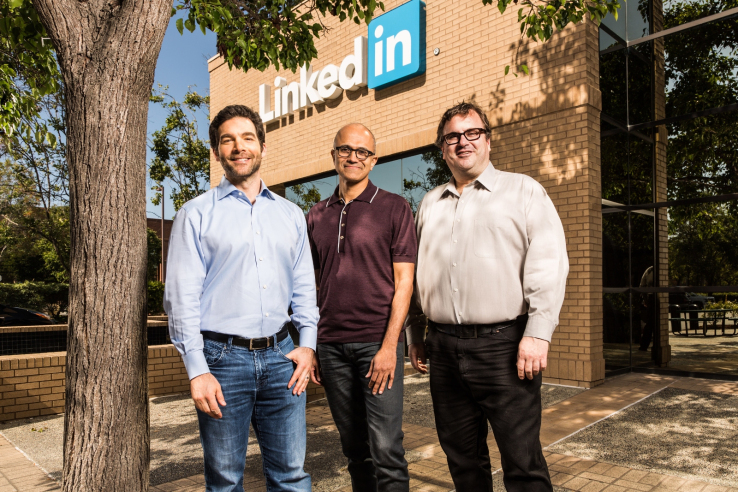Why LinkedIn’s Acquisition by Microsoft Will Disrupt the Enterprise Software Market

Originally posted on AltimeterGroup.com.
It was a very smart and strategic move for Microsoft to acquire LinkedIn. With its 433 million registered users (and their professional social graphs), not only is LinkedIn a singularly unique asset, its leadership, culture, and organization brings with it a new sense of mission that Microsoft’s CEO Satya Nadella has been pursuing in his turnaround efforts at the company.
Once the acquisition gets finalized and the companies come together, the combined Microsoft + LinkedIn organization will set a course that can significantly disrupt the enterprise software/services space. Here are three reasons why I believe this will be the case:
- Deep integration of the LinkedIn social graph into Microsoft products will make other offerings feel incomplete. There’s undeniable power in being able to pull social graph information — like a social profile, activities, and connections — directly into your work stream. LinkedIn enables this today at a basic level within email, calendars, and your CRM. But the real potential is for LinkedIn to provide an extra, exclusive level of analysis and insight to Microsoft customers — especially for Outlook and its CRM offering, Dynamics. One key player to watch is Salesforce, who is rumored to have rebuffed earlier acquisition efforts by Microsoft. The LinkedIn data may be a way to get Salesforce back to the negotiating table, especially if it makes the difference in deciding which CRM system to use.
- Google’s got no social game, Facebook’s got no enterprise game. Failed attempts at creating a social network via Google+ means that Google is flying blind when it comes to providing social context in its enterprise apps. While Google Apps provides a great alternative/addition to Microsoft Office, Microsoft is quickly catching up with Office 365 (although I still think Google Apps has greater flexibility and customization). But I believe that social data intelligence will quickly become addictive, and if it’s readily available via Microsoft, it will be a deciding factor, especially for more sophisticated organizations eager to tap into the social graph. And while Facebook @Work has been making some progress, the fact that enterprise didn’t appear on Mark Zuckerberg’s 10-year plan was not a vote of confidence in Facebook’s support of an enterprise approach. This is not an industry that you can “dabble” in — with formidable players in the space, I believe Facebook’s approach to @Work is to keep a few options available to satisfy the (minimal) enterprise social needs of its biggest consumer advertisers. Watch Microsoft + LinkedIn pull away from these two contenders, as it forges a new path for enterprise software.
- Social-infused human capital management becomes the new “it” area for enterprise software. One big opportunity for Microsoft is to take a social-first approach to the traditional space of human capital management (HCM), which has long been dominated by players like SAP, Oracle and IBM, or smaller software providers focused on recruiting. Microsoft has the potential to rethink the entire space from the ground up from a social perspective — such as understanding all of the activities of an employee both internally and externally. LinkedIn’s learning portal Lynda.com can become a tremendously valuable employee development and engagement platform that supports not just Microsoft products, but all aspects of work and life development.
While these are some exciting times for LinkedIn, there are a few “gotchas” that make me pause in my all-out enthusiasm for the deal. I’m on the lookout for three things:
- Integration versus independence. Microsoft bought Yammer, an enterprise social networking darling, and then proceeded to strip it of much of its magic in an effort to integrate into Microsoft Office offerings like SharePoint. This time around, there’s widespread commitment to keep LinkedIn as an independent unit — which can then slow down integration where it’s most needed to drive value. If the core business remains strong and independent, but the data is accessible via deep integration and rich APIs, then I think this will work. Don’t spend endless cycles trying to reconcile completely different value propositions and incentives — simply build LinkedIn data into Microsoft products as a value add to attract and retain customers. Keep. It. Simple.
- Alignment of mission and culture. LinkedIn CEO Jeff Weiner wrote that there were two things that he and Microsoft CEO Satya Nadella agreed to from the start — alignment on purpose and structure. I’ve known Jeff since his Yahoo! days and I’m always struck by the fact that every time I meet him — and I mean every time — he always begins the conversation with the mission of LinkedIn, which is “to connect the world’s professionals to make them more productive and successful.” Someone once asked him when he would stop talking about the mission. Jeff’s response: “When people stop looking surprised.” I’m going to be listening to see if the LinkedIn team continues to espouse that mission every single day. And if Microsoft, re-energized by Satya’s leadership, does the same. Without that focus on aligned purpose, this acquisition won’t ever fly.
- Social selling product evolution and maturity. Today, LinkedIn’s Sales Navigator provides a useful “skin” on its data to specifically support sales professionals eager to tap into the LinkedIn Network. But to be truly effective as a salesperson, you also need to act like a marketer and create content, while also listening closely to what customers and accounts are saying to be able to provide service in real-time. Neither LinkedIn nor Microsoft have these types of marketing automation and marketing technology chops readily available on their respective platforms. They will quickly need to develop marketing, content, and service capabilities to truly meet the needs of the dynamic, digital customer. This places even greater emphasis on partnering or acquiring an experience cloud expert, such as Salesforce, Oracle, or IBM.
